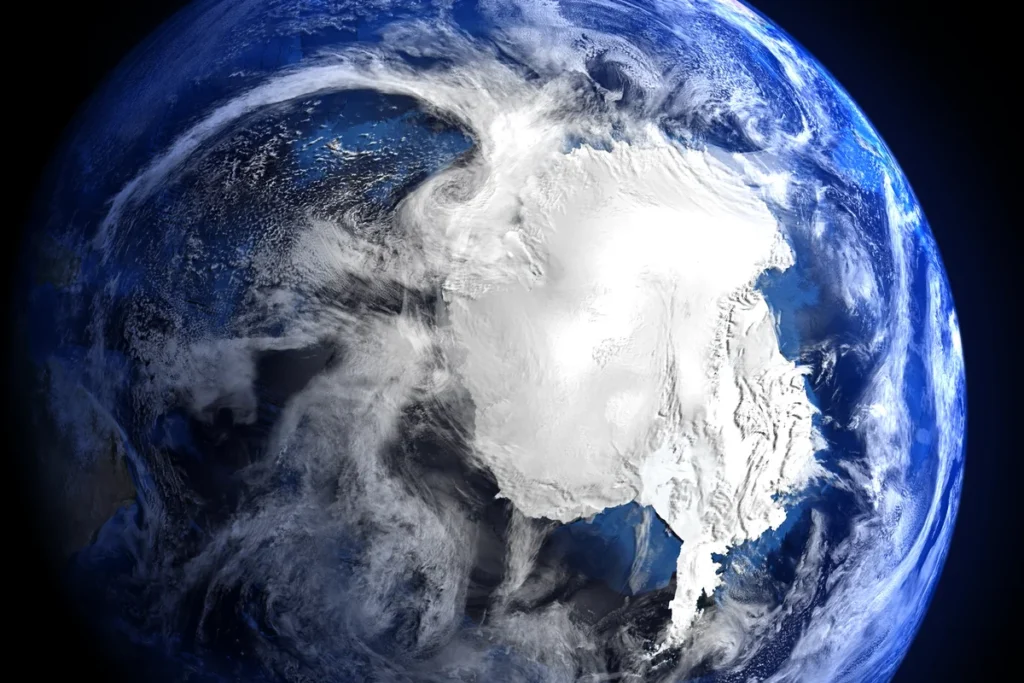Have you ever wondered what the coldest place on Earth looks like from space? Picture a vast, white expanse stretching as far as the eye can see, surrounded by the deep blue of the Southern Ocean. Antarctica, our planet’s southernmost continent, is a stunning sight from orbit, and it holds many secrets waiting to be uncovered. Let’s take a closer look at this icy wilderness from the perspective of astronauts and satellites.
The First Glimpse from Above
The first images of Antarctica from space were captured during the early days of space exploration. These initial photographs, taken by satellites and astronauts, revealed the continent’s immense size and unique geography. From space, Antarctica appears as a large, white mass with a rugged coastline dotted with ice shelves and glaciers. The sheer scale of the ice-covered landmass is breathtaking, covering an area of about 14 million square kilometers.
The Beauty of the Polar Ice
One of the most striking features of Antarctica from space is its ice. The continent is covered by an ice sheet that holds about 60% of the world’s fresh water. This ice sheet, which is up to 4.8 kilometers thick in some places, gives Antarctica its signature white appearance. The ice is not just a static, frozen expanse; it moves and flows, creating stunning patterns and formations that can be seen from space.
The Dynamic Landscape
Antarctica’s landscape is constantly changing. Satellite images show that the continent’s ice shelves and glaciers are in a state of flux, with some areas losing ice while others gain it. This dynamic environment is influenced by various factors, including climate change and ocean currents. Scientists use satellite data to monitor these changes and understand their impact on global sea levels.
The Aurora Australis: A Celestial Spectacle
One of the most magical sights in the Antarctic night sky is the Aurora Australis, or Southern Lights. From space, astronauts can witness this natural light show as it dances over the continent. The aurora is caused by charged particles from the sun interacting with the Earth’s magnetic field, creating beautiful green and red light displays. Seeing the Aurora Australis from space adds a new dimension to the already mesmerizing view of Antarctica.
Wildlife Seen from Space
Even from the vast distance of space, some of Antarctica’s wildlife can be observed. Large colonies of emperor penguins, for example, appear as dark specks against the white ice. These penguins are uniquely adapted to the harsh conditions of the continent, and their presence is a testament to the resilience of life in extreme environments. Satellites also track the movements of seals and whales in the surrounding ocean, providing valuable data for researchers studying these species.
The Role of Satellites in Research
Satellites play a crucial role in Antarctic research. They provide continuous, real-time data that helps scientists monitor the continent’s climate, ice cover, and ecosystems. This information is essential for understanding the effects of global warming on Antarctica and predicting future changes. Satellite technology has revolutionized our ability to study remote and inhospitable regions like Antarctica.
Human Presence in Antarctica
Though Antarctica is the most remote continent, it is not devoid of human activity. Various countries operate research stations there, and these facilities can be seen from space. The stations are often small clusters of buildings surrounded by ice, and they serve as bases for scientists conducting research on everything from glaciology to biology. The presence of these stations underscores the importance of Antarctica for scientific discovery.
Challenges of Living and Working in Antarctica
Living and working in Antarctica is no easy feat. The continent’s extreme cold, strong winds, and isolation pose significant challenges. Despite these hardships, researchers are drawn to Antarctica for the opportunity to study its unique environment. From space, the research stations look tiny against the vastness of the ice, highlighting the determination and resilience of the people who work there.
The Impact of Climate Change
Climate change is having a profound impact on Antarctica. Satellite images show that some areas of the continent are experiencing rapid ice loss, contributing to rising sea levels. The Antarctic Peninsula, in particular, has seen significant warming and ice melt. Understanding these changes is critical for predicting future impacts on global climate and sea levels. From space, the evidence of climate change is clear and compelling.
International Cooperation in Antarctic Research
Antarctica is a place of international collaboration. The Antarctic Treaty, signed in 1959, designates the continent as a scientific preserve and bans military activity. This treaty has facilitated cooperation among nations in conducting research and sharing data. From space, the various research stations and collaborative projects are a testament to the spirit of global partnership in the pursuit of knowledge.
The Future of Antarctic Exploration
The future of Antarctic exploration holds exciting possibilities. Advances in satellite technology, robotics, and remote sensing will continue to enhance our understanding of the continent. New missions, both manned and unmanned, will push the boundaries of what we know about this frozen frontier. From space, the potential for discovery seems limitless.
Conclusion: A Unique Perspective
Seeing Antarctica from space provides a unique perspective on this remote and mysterious continent. The vast ice sheets, dynamic landscapes, and glimpses of wildlife all contribute to the awe-inspiring view. Satellite images and astronaut observations have expanded our knowledge and appreciation of Antarctica, highlighting its importance in the global ecosystem. As we continue to explore and study this icy wilderness, the insights gained from space will be invaluable in our efforts to protect and preserve this fragile environment. So next time you look up at the night sky, remember that beyond the stars, there’s a frozen wonder waiting to be discovered.

